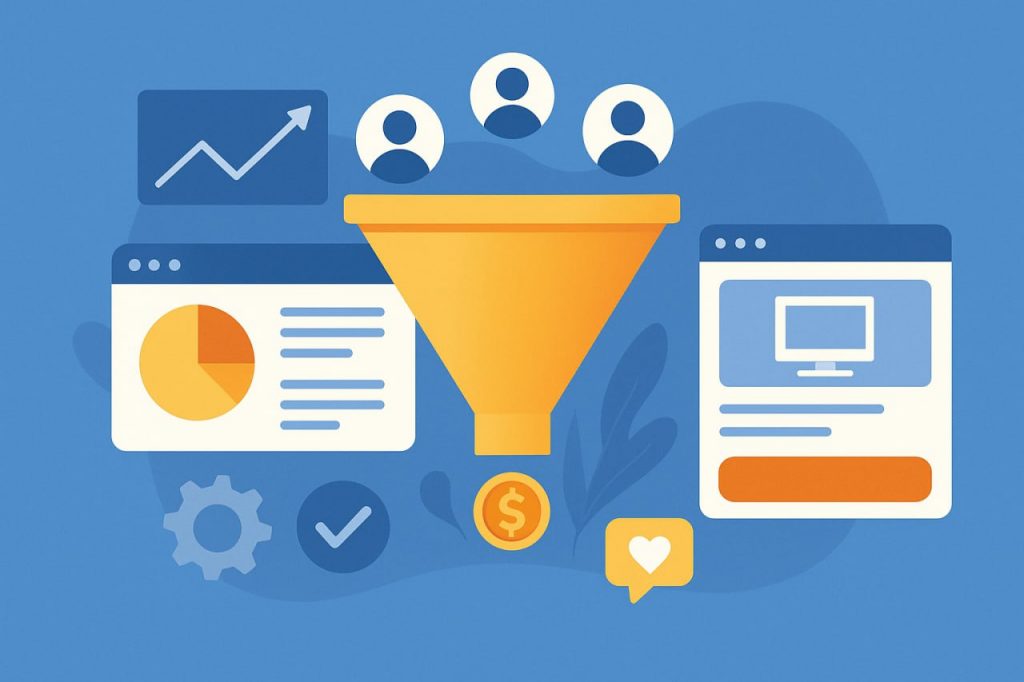
In the world of digital marketing, a company’s website is more than just an online business card. It’s a full-fledged platform for attracting, engaging, and converting visitors into customers. But to make your website perform these functions effectively, you need to properly structure a sales funnel — a step-by-step process that guides a user from their first contact with your brand to making a purchase or ordering a service.
In this article, we will break down how to build an effective sales funnel on your website, avoid common mistakes, and increase conversions. You’ll learn which tools are helpful at each stage and get practical tips that work in 2025.
What Is a Sales Funnel and Why Is It Important?
A sales funnel is a model of user behavior that shows the journey from first discovering your product or service to making a final purchase decision. Visually, it resembles a funnel because the number of people decreases at each stage. It’s not enough to just drive traffic to your website — it’s important to create a logical and appealing path that motivates users to take action.
A typical sales funnel includes the following stages:
- Awareness — a potential customer learns about your brand or website.
- Interest — they start exploring your offer and looking for more information.
- Desire — they form a positive impression and evaluate the benefits.
- Action — they decide to make a purchase or use your service.
- Retention — the customer returns, forming loyalty.
Step 1: Traffic Generation — Attracting Potential Clients
To activate your funnel, you need to draw attention to your website. The most effective channels in 2025 include:
- SEO optimization — tuning content, titles, and technical elements to match search queries. For example, blog articles like “How to Choose Hosting” or “Why You Need an SSL Certificate.”
- Google Ads — instant results when properly configured.
- Social media — advertising and content marketing on Facebook, Instagram, TikTok, LinkedIn.
- Email campaigns — subscriptions that help build long-term relationships.
For better SEO, use domain registration from RX-NAME — it helps create a short and relevant domain name, boosting your visibility on Google.
Step 2: Capturing Interest and Showing Expertise
Once users land on your site, you have just seconds to show them how you can help:
- Create an appealing homepage design — clear structure, navigation, and quality visuals.
- Use simple language, avoiding complex jargon.
- Add client reviews, before/after photos, certifications, partner logos.
- Offer a free consultation or demo — a powerful way to engage visitors.
Don’t forget about security: having an SSL certificate not only protects data but also builds trust and improves search rankings.
Step 3: Creating Desire — Showing Value
Now that you have your visitor’s attention, it’s time to create the desire to buy:
- Use emotional triggers: limited-time offers, countdowns, bonuses.
- Share real case studies or customer stories.
- Provide a comparison table of plans, showing what each option includes.
- Add an FAQ block answering common questions.
Step 4: Call to Action — Turning Visitors into Clients
The final step is converting your visitor into a paying customer:
- CTA buttons should be visible, simple, and persuasive (“Order Now,” “Get a Free Consultation”).
- Contact forms should be short and only request essential information.
- Add live chat to respond to objections instantly.
- Use automated email confirmations after a user completes an action.
Remember: website stability is crucial. Reliable hosting from RX-NAME ensures fast loading speeds and uninterrupted access for your users.
Step 5: Client Retention — Repeat Sales and Loyalty
Your funnel doesn’t end after the first sale. The most valuable customer is the one who returns:
- Implement loyalty programs.
- Collect feedback and thank customers for their purchases.
- Use email marketing with personalized offers.
- Launch referral programs — offer bonuses for bringing friends.
Conclusion
A properly built sales funnel is not just a marketing tool. It’s a systematic approach to interacting with your audience that helps maximize your resources, increase profits, and build long-term relationships.
Start with the basics — choose a domain name, set up hosting, secure your site with an SSL certificate, and gradually build your funnel step by step.
Follow the RX-NAME blog — we regularly publish useful content to help grow your online business!

Leave a Reply